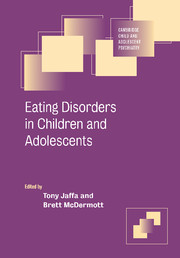Book contents
- Frontmatter
- Contents
- List of Contributors
- Part I Introduction
- Part II Scientific underpinnings
- Part III Abnormal states
- 9 Anorexia nervosa in children and adolescents
- 10 Eating disorders in boys
- 11 Bingeing and bulimia nervosa in children and adolescents
- 12 Selective eating and other atypical eating problems
- 13 Comorbid anxiety and depression and the role of trauma in children and adolescents with eating disorders
- 14 Eating disorders in children with disabilities and chronic illness
- 15 Childhood obesity
- Part IV Evidence-based care
- Part V Public health perspectives
- Index
- References
10 - Eating disorders in boys
from Part III - Abnormal states
Published online by Cambridge University Press: 02 December 2009
- Frontmatter
- Contents
- List of Contributors
- Part I Introduction
- Part II Scientific underpinnings
- Part III Abnormal states
- 9 Anorexia nervosa in children and adolescents
- 10 Eating disorders in boys
- 11 Bingeing and bulimia nervosa in children and adolescents
- 12 Selective eating and other atypical eating problems
- 13 Comorbid anxiety and depression and the role of trauma in children and adolescents with eating disorders
- 14 Eating disorders in children with disabilities and chronic illness
- 15 Childhood obesity
- Part IV Evidence-based care
- Part V Public health perspectives
- Index
- References
Summary
Introduction
To the public and many clinicians eating disorders are synonymous with girls and young women. The experienced clinician knows this is not the case. This chapter will discuss eating disorders in boys. In the past this endeavour would have been hampered by a dearth of empirical studies. Fortunately, recent community and population-based studies have included boys in their sampling frame. However, the research literature on treatment and outcome in boys with eating disorders is far more limited, often to the point of no separate analysis of outcomes in the male subset of the sample.
Given that the strength of the current literature is community-based studies of putative modifiable determinants of eating disorders, such as body dissatisfaction, the chapter will begin with this area and then discuss eating disorder psychopathology and the prevalence of eating disorders diagnoses in boys. The chapter will conclude with treatment research available in this group. Past research that applied a developmental perspective to other psychopathology areas suggests gender differences across time should be expected. For example longitudinal research of depressive symptoms finds gender equality before 12 years of age (McGee et al., 1990), followed by elevated rates with earlier onset in adolescent girls (Kashani et al., 1987).
The key determinants in childhood eating disorders considered include psychological constructs such as body dissatisfaction and its influence on dieting and other weight loss strategies, biological factors such as height, weight, body mass index (BMI) and pubertal status, the experience of traumatic events including various forms of abuse and socio-cultural factors including family, peer and media influences.
Keywords
- Type
- Chapter
- Information
- Eating Disorders in Children and Adolescents , pp. 123 - 132Publisher: Cambridge University PressPrint publication year: 2006
References
- 1
- Cited by

